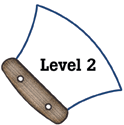
Alaska Science
Key Element A15
A student who meets the content standard should use science to understand and describe the local environment (Local Knowledge).
 |
Alaska Science A student who meets the content standard should use science to understand and describe the local environment (Local Knowledge). |
|
Performance Standard Level 2, Ages 8–10
|
|
|
|
Sample Assessment Ideas
|
|
|
Expanded Sample Assessment Idea
|
|
Procedure Students will:
Reflection and Revision
|
Levels of Performance |
||
|
Stage 4 |
Student work is complete, contains extensive evidence of knowledge regarding resource and limiting factors and shows evidence of logical reasoning. Research for presentation includes multiple sources. Presentation is well organized, interesting, informative, and includes several visual aids. | ||
|
Stage 3
|
Student work shows evidence of logical reasoning but may contain minor errors or omissions. Student work contains evidence of knowledge regarding resources and limiting factors. Research for a presentation includes more than one source. Student work is organized, interesting, informative, and includes at least one visual aid. | ||
|
Stage 2
|
Student work is incomplete, may contain errors of science fact and reasoning, and shows limited understanding of resources and limiting factors. Research for presentation may be limited to one source. Presentation includes at least one visual aid though it may lack organization. | ||
|
Stage 1
|
Student work is largely incomplete, may be inappropriate for age level or subject matter and may contain major misconceptions regarding resources or limiting factors. | ||
Standards Cross-References
|
||
|
National Science Education Standards All organisms cause changes in the environment where they live. Some of these changes are detrimental to the organism or other organisms, whereas others are beneficial. (Page 129) Soils have properties of color and texture, capacity to retain water, and ability to support the growth of many kinds of plants, including those in our food supply. (Page 134) The surface of the Earth changes. Some changes are due to slow processes, such as erosion and weathering, and some changes are due to rapid processes, such as landslides, volcanic eruptions, and earthquakes. (Page 134) Some environmental changes occur slowly, and others occur rapidly. Students should understand the different consequences of changing environments in small increments over long periods as compared with changing environments in large increments over short periods. (Page 140) A population consists of all individuals of a species that occur together at a given place and time. All populations living together and the physical factors with which they interact compose an ecosystem. (Page 157) |
Benchmarks Waves, wind, water, and ice shape and reshape the Earth’s land surface by eroding rock and soil in some areas and depositing them in other areas, sometimes in seasonal layers. (Page 72) Rock is composed of different combinations of minerals. Smaller rocks come from the breakage and weathering of bedrock and larger rocks. Soil is made partly from weathered rock, partly from plant remains—and contains many living organisms. (Page 72) A great variety of kinds of living things can be sorted into groups in many ways using various features to decide which things belong to which group. (Page 103) For any particular environment, some kinds of plants and animals survive well, some survive less well, and some cannot survive at all. (Page 116) Insects and various other organisms depend on dead plant and animal material for food. (Page 116) Organisms interact with one another in various ways besides providing food. Many plants depend on animals for carrying their pollen to other plants or for dispersing their seeds. (Page 116) Changes in an organism’s habitat are sometimes beneficial to it and sometimes harmful. (Page 116) Most microorganisms do not cause disease, and many are beneficial. (Page, 116) |
|
Table of Contents | Return to Alaska Native Knowledge Network